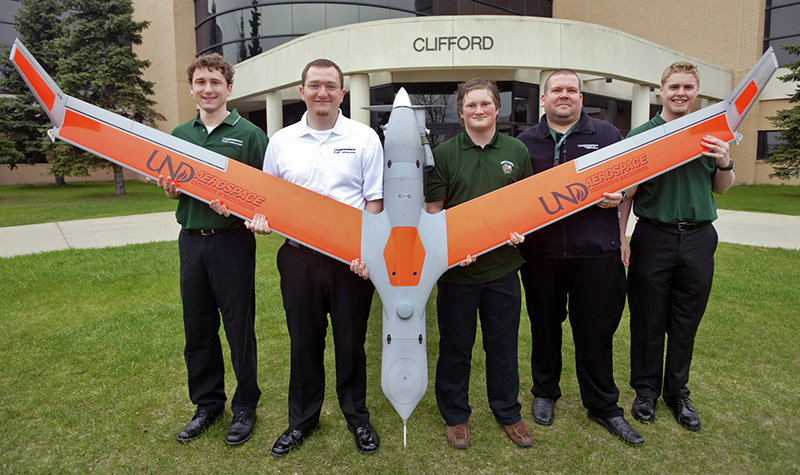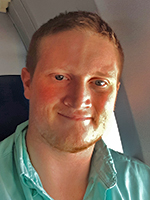07 Dec UND grad makes most of his UAS degree
Brett Whalin, UND Class of 2011: ‘When I was hired, it was because they were impressed with my resume’

In 2009, UND was the first university of offer a degree in Unmanned Aircraft Systems (UAS) Operations. In 2011, the first UND Aerospace students graduating with a UAS degree were (left to right) Adam Julson, Chris Burger, Brett Whalin, Jeremy Duke and Alex Gustafson. They’re shown in May 2011 outside of Clifford Hall with an Insitu Scan Eagle. Archival image.
In 2011, Brett Whalin was one of the first five students in the United States to graduate with a degree in unmanned aircraft systems (UAS) operations from the University of North Dakota John D. Odegard School of Aerospace Sciences.
When he graduated, Whalin described his decision to pursue a career in the UAS field as “a challenge and a great opportunity.” However, the Rapid City, S.D., native was just beginning to learn true the nature of the challenge. Although UND Aerospace had decades of experience in training pilots for commercial aviation, the UAS industry was still in its infancy, and opportunities were limited.

Brett Whalin
Whalin recalled that his career choice was something of a risk because of uncertainty about when the Federal Aviation Administration (FAA) would allow UAS to fly commercial missions in the national airspace. It took more than five years before the FAA finalized its Part 107 regulations, enabling small unmanned aircraft to fly commercial missions under an altitude of 400 feet and within line of sight of the UAS operator.
“This cracked open the potential for U.S. jobs, but still only in a limited way,” Whalin said. “I think the FAA still has much work in this respect, compared to its foreign counterparts. The U.S. market is growing, but is still limited.”
Whalin has worked in the UAS industry since April 2012, primarily with military customers as a UAS pilot flying missions overseas and maintaining unmanned aircraft. He’s also instructed other civilians flying UAS missions for the military. It was a career path with its own challenges because most new college graduates don’t have the security clearances needed to work with the military.
A ‘guinea pig’
“When I finally got to do some work, it was with BOSH Global Services,” Whalin said. “They exclusively hired veterans. When I was hired, it was because they were impressed with my resume, but they also wanted to expand their knowledge base. I was told when I was hired that I was the guinea pig to see if they wanted to continue to hire any more civilians.”
Whalin did well at BOSH (now part of MAG Aerospace), which is based in Newport News, Va. In 2013, he received the company’s Vice President of Operations Service Award. He was with BOSH for nearly three years, sometimes working in what he described as “austere locations overseas.”
In May 2015, Whalin went to work for Insitu Inc., a subsidiary of Boeing, where he held the positions of UAS operator, maintainer and field trainer. After three years at Insitu, Whalin joined Academi, a global training and logistics management company headquartered in Reston, Va. He worked overseas as a UAS pilot and maintainer.
Whalin recently accepted a position with Arcturus UAV in Rohnert Park, Calif., where he is a subject matter expert. The company manufactures and configures UAS, ground control stations and launch systems.
UND’s aviation professionalism

In this 2011 photo, UND Aerospace student Taylor Butterfield is shown carrying a Scan Eagle unmanned aircraft after a flight near Olso, Minn. Archival image.
“Companies now see the merit of someone with an aviation engineering/flight background, and are more willing to sink in the money – if the candidate looks promising,” Whalin said. “I think this is a direct result of how UND molded us and our aviation professionalism.”
He believes the high standard of professionalism achieved by UND’s first wave of UAS graduates has helped pave the way for those who followed.
In the following Q&A, Whalin discusses with UND Today the role his education at the University has played in his UAS career.
How has your UND degree in UAS operations helped you achieve your career goals?
My experience at UND has helped me in many ways toward being able to distinguish myself. My aviation knowledge has helped me save many aircraft from emergencies, as well as keep a cool head to help others during their in-flight emergencies. UND taught me remote sensing and telemetry. I understand how the cameras actually work, versus just knowing their settings. My knowledge of radio wave propagation has also helped me troubleshoot, get out of or mitigate jamming while on the job, in ways that weren’t as obvious to some of my co-workers.
Lastly but most importantly, the multiple cultures represented in UND’s aviation school opened me up to more of the world than some get, which, in my traveling job, makes all the difference.
What advice would you give to a young person interested in pursuing a career in the UAS industry today?
My best advice is to become a manned pilot. It will give you so many advantages such as knowledge, professionalism via crew resource management (CRM) and decision making. Not to mention, it is a great way to spend a sunny weekend.
The other thing is to learn networking. It’s the backbone of what we do. Our radios are a network. We get to our customer via networks. All of our equipment is based on computers, so learning how they talk is important. Knowing how to build cables for both networking or power becomes critical on site when a backhoe runs over your ethernet or fiber cable. You have to either replace or fix it. Best Buy is not an option in places like Afghanistan.
What have been some of your best experiences while working in the UAS industry?
Some of the best experiences I have had in this industry are related to the impacts my co-workers and I have had. Overseas, we have ensured troops came home. In the states, we have saved houses from fires and kept fire department personnel safe. These people rarely meet us, but seeing their house standing or their military vehicle returning to the base, is a perspective that all UAS professionals should have.
Where do you see the UAS industry headed in the next 5 to 10 years?
In the short-term, VTOL (vertical takeoff and landing) is definitely going to take over more and more of the UAS market. Drone swarms are also going to become more popular. Several companies have proven the viability of commercial UAS enterprises in the U.S. While still highly expensive, they do show the need and use of medium-endurance UAS options. On a smaller scale, the real estate market has been using small UAS for a while now. Cloud and software-defined networking are also going to start affecting the field in big ways.
While the U.S. market is very small at the moment – compared to what I see it becoming – the pressure is building. Part 107 was able to finally let some of that pressure manifest itself into jobs in the U.S., but the FAA still lags behind its foreign counterparts. As unmanned aviation becomes more regulated and integrated into the manned aviation network, the market will truly take off. To get ahead when those days come, one must adapt to being an engineer and being able to either design or build a UAS. Both take different, complimentary talents. Pilots who are computer savvy and have technical knowledge – similar to what UND has given me – will be even more viable in those jobs.


